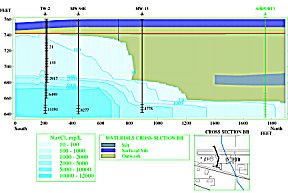DYNCFT
Coupled Flow-Transport Modeling Code

DYNCFT simulates 3-dimensional contaminant transport with dispersion and first-order decay and/or linear equilibrium adsorption. Conservative constituents (such as chloride and tritium) may be simulated as well.
DYNCFT is based on the Lagrangian approach ('Random Walk" method for statistically significant number of particles, each particle having an associated weight, decay rate, and retardation).
DYNCFT can also be used for transport modeling of dissolved contaminants, without variable density fluids.
DYNCFT's features:
- Simulates fully coupled, 3-D flow and transport
- Simulates density-dependent flow - allows effects of fluid density gradients associated with solute concentration gradients to be incorporated.
- Based on the finite element method of numerical integration.
- Solves both confined and unconfined ground water flow and transport equations under many types of natural and artificial aquifer stresses.
- Accepts various types of boundary conditions, including:
- Specified head boundaries (points of known head)
- Specified flux boundaries (natural recharge, pumping, no-flow streamlines, artificial recharge, etc.)
- Rising water boundaries that are hybrid boundaries (specified head or flux depending on system status)
- "Third-type" boundaries (where fluxes are specified as a function of aquifer head)
- Simulates both variable and fixed concentration sources of contamination, which may be specified implicitly or explicitly.
back...














